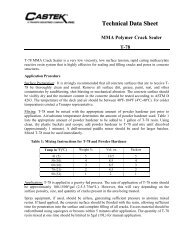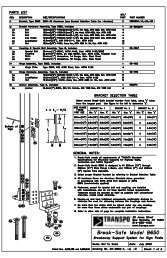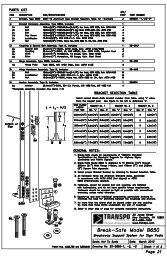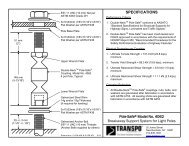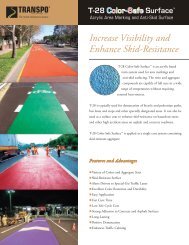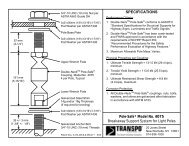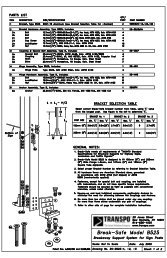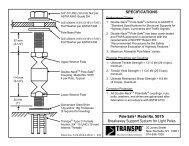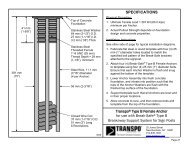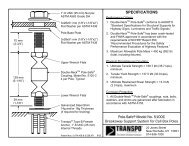Oil Absorbing Pads - Transpo Industries, Inc.
Oil Absorbing Pads - Transpo Industries, Inc.
Oil Absorbing Pads - Transpo Industries, Inc.
Create successful ePaper yourself
Turn your PDF publications into a flip-book with our unique Google optimized e-Paper software.
X-TEX <strong>Oil</strong> Sorption Propertieshttp://www.xextex.com/testdata/oil_sorption_properties.htmPage 1 of 44/27/04HomeApplicationsEndorsementsTest DataOur TeamNewsContact UsUltraTechJerry M.BrownsteinPresident & CEOPhone:(425)392.3848Fax:(425) 392. 0222Email:jb@xextex.com<strong>Oil</strong> Sorption Properties of X-TEX vs. Polypropylene for Stormwater Catch Basin InsertsIntroduction- Both industry and municipalities are increasingly utilizing stormwater basin inserts as a best management practice (BMP) control for storm waterrunoff pollution control. The inserts are closest to “point of origin” and in manycases the only line of defense for protecting our waterways from secondarypollution sources. The storm water inserts used today are devices that are installedinto catch basins to help reduce pollutants that are washed off automobile parkinglots, roadways, etc. These inserts must be strong enough to withstand the physicalabuse of the environment and the introduction of up to several pounds of sediment(1). The oil adsorption capabilities and physical properties of the inserts must notsignificantly degrade for many months after installation to insure limitedmaintenance and assure cost effectiveness.Most catch basin inserts in use today are constructed of “virgin” polypropylenematerial, which has an oil and grease removal efficiency of 78 to 87 percent (2,3).No “recycled” adsorptive material was found that had the same or better adsorbentabilities and physical properties as polypropylene based materials…..until now.Now a new textile has been successfully developed from a blended bulk fiber mediaderived from “recycled polymeric waste”. This textile “blanket” has superior oiladsorption and absorption, physical attributes that withstand the rigors of theenvironment and is cost effective. The textile blanket and blended fiber material areregistered under the trade name Xextex (patent pending). X-TEX gives engineers,designers and manufactures an innovative recycled material for their storm waterinserts. X-TEX is currently being used successfully in storm water filtering systemsfor the removal of free oil and grease, and many types of emulsified oils as foundon construction sites and in truck washing facilities.The following tests compares the oil and grease adsorption properties and capacityof polypropylene 225EX material and the X-TEX Blanket material. Both materialsare similar in weight per volume basis. An equal size and weight of each materialwas used.Method- A test apparatus was designed to evaluate the insert performance andabsorbance/adsorbance of X-TEX and polypropylene. A 9 by 12 inch drain framewas assembled using heavy plastic strips. Each test material was cut into a 14 by18 inch rectangle that allowed for a 4-inch deep pocket to be formed for theintroduction of the effluent oil stream. The insert material was clamped betweenthe plastic frame and PVC pipe was used to deliver a constant water flow of 10liters per minute. The end section of the pipe was perforated to allow evendistribution of water over the entire length of the test area pocket.
X-TEX <strong>Oil</strong> Sorption Propertieshttp://www.xextex.com/testdata/oil_sorption_properties.htmPage 2 of 44/27/04A mixture of 50 percent used motor oil and 50 percent diesel was injected into thePVC delivery pipe using a metering pump. The oil was metered into the influentstream at one gram per minute, and the flow rate was held constant at 10 liters perminute, yielding a 100 mg/l influent waste stream. Although this concentration ismuch higher than actual environmental field conditions, the amount of oil effluentwas sufficient to measure a break-through point of each material.The two materials were tested at both a single and a double thickness at highconcentrations to determine if additional removal efficiencies could be improved byusing more material. Each material tested was exposed to a total of a 10-minuteflow of oil/water effluent. Samples were collected at 1,2,4,6,8 and 10 minuteintervals of filtering. A total of 10 grams of oil was discharged with 100 liters ofwater for each test. The oil/water effluent passed through both materials for alltests without collecting or pooling. Samples were analyzed using EPA 418.1 methodfor total petroleum hydrocarbons.Results- The results from this bench test demonstrate that the X-TEX Blanket outperforms the polypropylene material substantially for the single layer and doublelayers of material.For the single layer the polypropylene break-through of the effluent occurred justafter two minutes of testing with a drop from 84% to 64% removal rate. The X-TEX material maintained a high percent of removal until break-through betweenthe 9th and 10th minutes of the test when the removal rate dropped from 85 % to69 %. There was no break through for the two layered X-TEX material or thepolypropylene textile under the test conditions. Table 1 summarizes these results,and Graph 1 shows these test results in percentages.Diesel / Motor <strong>Oil</strong> Removal from Water – Polypropylene Textile vs. X-TEX BlanketTable 1Time (min)Amount of Diesel/<strong>Oil</strong>AddedTotal(grams)<strong>Oil</strong>/Water(ppm)Amount ofDiesel/<strong>Oil</strong>Removed (ppm)PPL Insert X-TEX PPL InsertAmount of Diesel/<strong>Oil</strong>Removed (percent)X-TEX1 0.88 88 65 87 74 992 1.76 88 74 87 84 994 3.52 88 56 86 64 976 5.28 88 31 75 36 858 7.04 88 20 75 23 8510 8.8 88 17 61 20 70Graph 1- Percent of removal for single layer test
X-TEX <strong>Oil</strong> Sorption Propertieshttp://www.xextex.com/testdata/oil_sorption_properties.htmPage 3 of 44/27/04Conclusions- The test data illustrates that the polypropylene textile materialinitially retains about 80% of the oil/diesel blend while the X-TEX Blanket retainsvirtually 100% of the oil from the influent waste stream. With a 10-gram total oilinfluent load, the polypropylene textile removed 6.0 grams of oil and allowed 4.0grams of oil into the effluent stream, resulting in a 60% oil removal rate for theentire test. The X-TEX blanket removed 9.0 grams and allowed 1.0 gram of oil topass through removing 90% of the total oil.<strong>Oil</strong> breakthrough / saturation for the polypropylene textile occurred after 2 gramsof oil/diesel had been retained. For the X-TEX blanket the breakthrough /saturation point was after 8 grams of oil retention, indicating an oil retentioncapacity four times greater.The actual adsorption area was restricted to a 4 x 8 cm. area representing theeffluent flow at the low point of the insert pouch. This effluent point will shift assediment excludes exit sites in real-world inserts, and the oil adsorption capacitywill extend to the entire insert surface area, greatly increasing the inserts totalcapacity. The oil/diesel influent concentrations used in these tests wereintentionally high and were meant to determine an insert materials capacity, notsimulate real world conditions.Test Conducted by: Brent Hepner, Vice President and Director of ProductDevelopment, The Xextex Corporation USA, Assisted by Tom Coyner TechnicalDirector for Product Design, The Xextex Corporation USA.Acknowledgements- Thanks go to Planet CPR and Mark Shaw of Ultratech fortheir help both technically and with their assistance in supplying us with catch basininsert material for our comparison tests.
X-TEX <strong>Oil</strong> Sorption Propertieshttp://www.xextex.com/testdata/oil_sorption_properties.htmPage 4 of 44/27/04References1. M.E.Hrachovec, and P.E., G.R.Minton, PhD., P.E. (2001), “Field Testing of aSock-Type Catch Basin Insert”.2. M.E.Hrachovec, P.E., and G.R.Minton, Phd., P.E. (2001), “Bench Testing of aSock-Type Catch Basin Insert for Removal of Free Petroleum”.3. M.K. Stenstrom, S.L Lau, and E.Khan (1998). “Catch Basin Inserts to ReducePollution From Stormwater”.Home Applications Endorsements Test Data Our Team News Contact Us UltraTechCopyright 2001, 2002, 2003, all rights reserved. X-TEX and Xextex are registered trademarks of the Xextex Corporation, USA.Patented.Xextex products are recycled.




